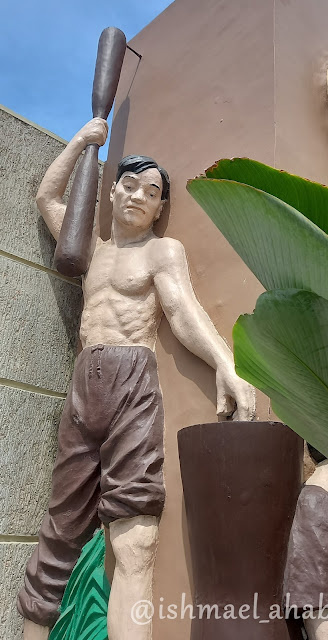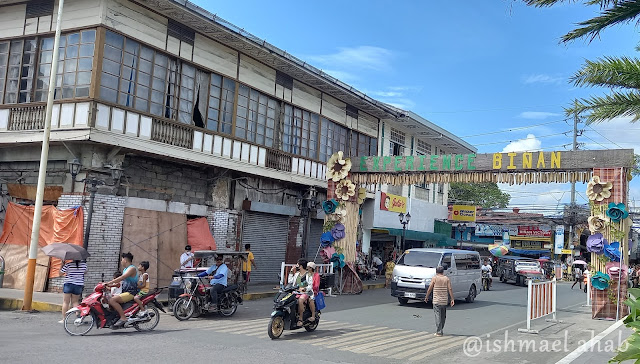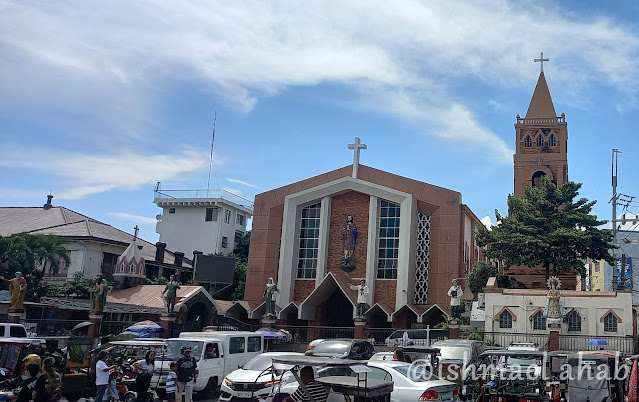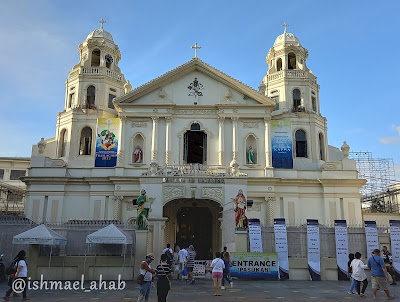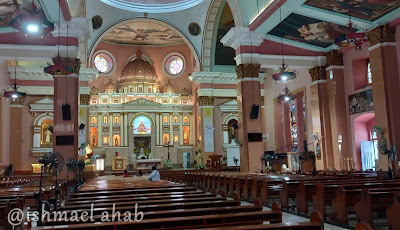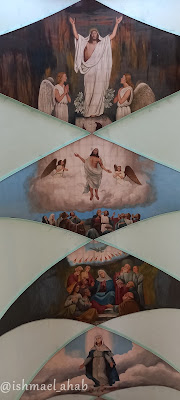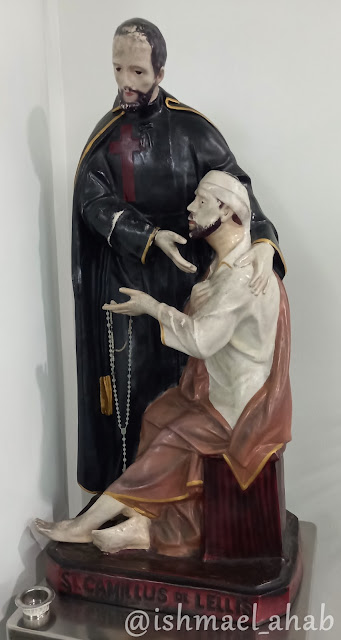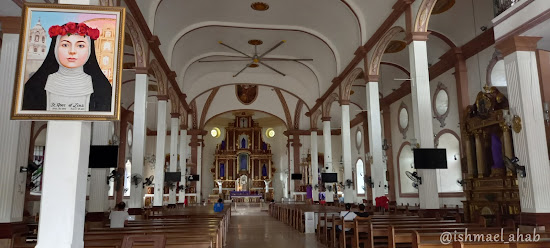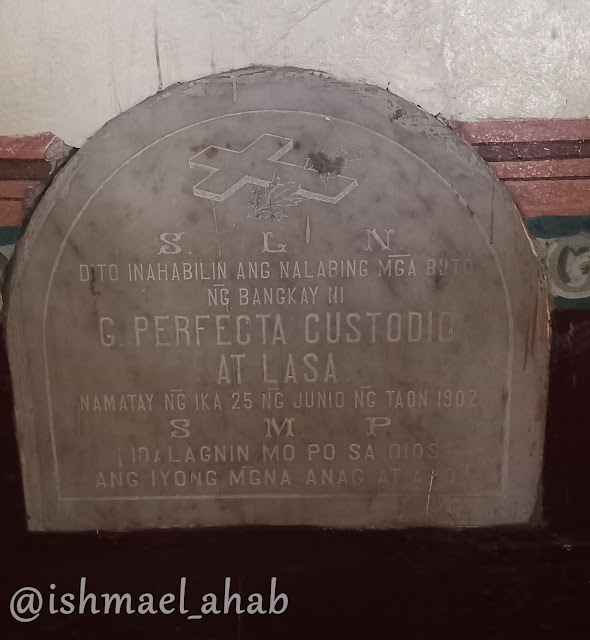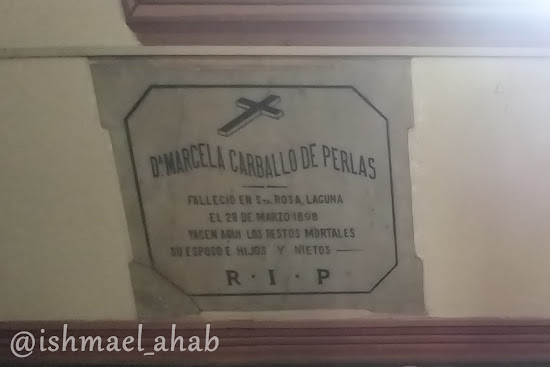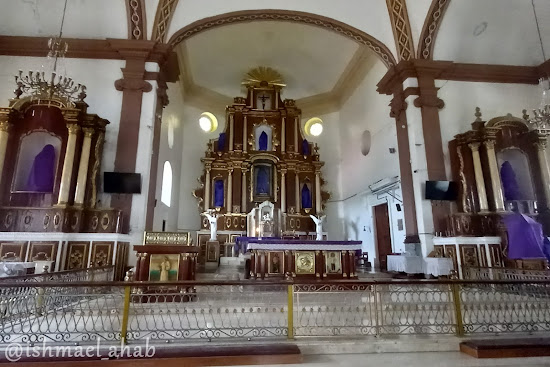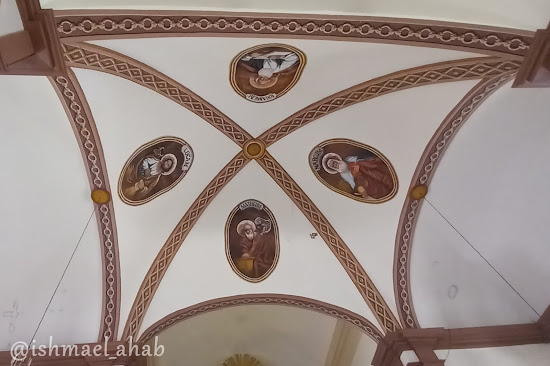During the Second World War, when Japanese soldiers ravaged the land,
residents of the lowlands of Laguna claimed that a lady in black and white
appeared to them and told them to seek refuge in the town of Santa Rosa. They
said that the lady told them that they will not go hungry because rice and fish
are plentiful in the town of Santa Rosa. Upon reaching Santa Rosa, they realized that the
lady who talked to them is Santa Rosa de Lima, who is the patron saint of the
town. This story is just one of the miracles of Santa Rosa de Lima for the
residents of the town named after her.
Santa Rosa de Lima Church is the oldest church in Santa Rosa City. In fact,
the church’s history is intimately connected to the city's history because the church
was established with the town.
Santa Rosa de Lima Church, just like in the typical old towns of the
Philippines, is located at the center of the town beside the plaza and the
government buildings. The church is now partially covered by Santa Rosa City’s
Rizal Park.
The church started as a visita of Bucol, which is the old name of Santa Rosa
when it was still a barrio of Biñan. The construction of the current church
structure began in 1790 by the Spanish Dominican friars, who recruited Chinese
laborers for the project. It is claimed that the old Chinese families in Santa
Rosa descended from these Chinese laborers.
The construction was finished in 1792 and the Dominican friars selected Santa
Rosa de Lima, also a Dominican, as the patroness of the new parish.
Simultaneously, Barrio Bucol was also made a new municipio or municipality of
Santa Rosa on January 18, 1792.
The first Mass honoring Santa Rosa de Lima in the new church was done on August 30,
1812 by Fray Francisco Favie, who was the first parish priest of the new town. August 30 is formerly the feast day for Santa Rosa de Lima.
I felt the centuries of history when I visited Santa Rosa de Lima Church. It
is clear by just looking at its exterior that it is a very old church. The
walls are of adobe blocks, which is similar to the ones used in the much older
Saint Polycarp Church in Cabuyao. However, unlike the Cabuyao Church with a
big bell tower, Santa Rosa de Lima Church has a smaller and less prominent
bell tower.
I read that Santa Rosa de Lima Church has 8 majestic bells, with each of them
having their own name.
The facade is made of gray adobe blocks, which is typical of the churches made
during the Spanish period.
The facade features the four Evangelists and other saints. I think at the top
is the image of the Virgin Mary.
In front of the church is the statue of Santa Rosa de Lima flanked by the
statues of Saint Catherine of Siena, Saint Martin de Porres, and two other
saints.

The statues of Santa Rosa and other saints were erected to commemorate the
visits of two ambassadors of Peru. The first Peruvian ambassador who visited
was Victor Aritomi-Shinto in 1999 and the second one was Julio Cardenas in
2000.
The church’s door is simple, not as ornate as the ones in Manila Cathedral or
San Agustin Church in Intramuros.
The church is cavernous and much spacious compared to Balibago Church.
What immediately caught my attention upon entrance to the church are the
tombstones on the wall.
I consider tombstones on the wall as proof that a church is old. The practice
of burial of the dead inside the church was a common practice during the
Spanish Period. Such practice was discontinued during the American Period when
the Americans instituted their health and sanitary laws that prohibited burial of the dead within the church premises.
The oldest tombstone that I saw is dated March 28, 1898.
It is Holy Week when I visited so all of the images, excluding the Crucified
Jesus, are veiled.
What’s interesting is that the parish kept the altar rails in front of the
altar. The rails are used to separate the pews from the holiest part of the
church.
Another purpose of the rails is this is where the faithful kneel to receive
the Holy Communion. Note of the kneelers in front of the altar rails.
The painting of the four Evangelists on the ceiling reminded of the similar
painting in St. Polycarp Church of Cabuyao.
On the side ceiling are the paintings of the apostles.
At the end of the ceiling is the image of Judas Iscariote. The word
“Iscariote” was painted over but I can still read it.
The image is definitely of the traitor because it is the only whose name is
not preceded by an S., which is the abbreviation for the Spanish word "San" or
saint in English. I guess this is the only church where Judas Iscariot was
depicted positively.
The current paintings on the ceiling are not the original ones. It is said
that the original paintings were great attractions from 1923 to 1960. The said
paintings, which featured the Assumption of the Virgin Mary, Coronation of the
Apostles, San Roque, and other Biblical scenes and saints, are comparable to
the ceiling paintings of Quiapo Church. The original paintings were removed
because they were destroyed by old age and bats. The only original paintings
that remained are those of King David and Saint Cecilia at the choir loft. I
do hope that these remaining paintings will be preserved.
The old paintings were replaced by the modern giant electric fans!
At the side is the spiral staircase to the choir loft.
Sadly, the caretakers of the church did not permit to climb up the stairs to
have good look of the choir loft and the remaining original paintings.
The church also has the baptistry that has a marble baptismal font, an image
of Jesus holding a thurible, Santo Entierro, and the veiled replica of the
Pieta.
My visit to Santa Rosa de Lima Church was just short. But in that brief time I
felt the intensity of history that the church represents. The church of Santa
Rosa de Lima is the witness to the birth of the town, its sufferings during
wars, and its growth into a city that touts itself as the Lion City of the
South.
- - -
Visita Iglesia is a Catholic tradition of visiting seven or
fourteen churches during Maundy Thursday. For each day, this Holy Week, I will
feature one church as a sort of virtual Visita Iglesia.
Read about the churches that I visited this year
Palm Sunday: Immaculate Conception Church in Concepcion Uno, Marikina
Holy Monday: Santo Niño de Paz Chapel in Greenbelt, Makati
Fig Tuesday: Our Lady of the Most Holy Rosary Chapel in SM Makati
Spy Wednesday:
Santa Rosa de Lima Church
in Santa Rosa, Laguna
Maundy Thursday:
Saint John Paul II Chapel in NAIA Terminal 3





